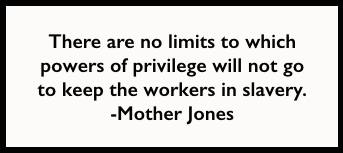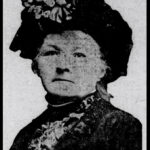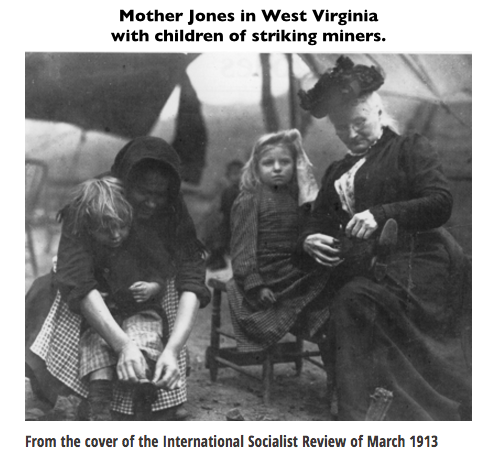 —————
—————
Hellraisers Journal – Friday February 21, 1913
Kanawha County, West Virginia – Mother Jones Arrested; Class War Rages
From The Wheeling Majority of February 20, 1913:
 —————
—————
Hellraisers Journal – Friday February 21, 1913
Kanawha County, West Virginia – Mother Jones Arrested; Class War Rages
From The Wheeling Majority of February 20, 1913:
 —————
—————
Hellraisers Journal – Thursday February 13, 1913
Holly Grove, West Virginia – Mother Jones Speaks at Funeral of Francis Estep
From The Washington Times of February 11, 1913:

Cesco Estep, striker…was buried yesterday [February 10th near Holly Grove, West Virginia]. At his funeral, “Mother” Jones made an appeal to the men to get their guns and “Shoot them to hell,” meaning the mine watchmen and others who will not join their ranks.
[Emphasis added.
Note: Initial reports, in newspapers across the nation, claim that a striking miner, “Robert Estep,” was killed during rioting at Mucklow. In fact the striking miner killed was Francis Estep, member of the United Mine Workers of America. He was murdered at Holly Grove by gunthugs firing upon men women and children from a train-car called the “Bull Moose Special.” The attack was perpetrated against the small village at about 10 p. m. Residents scrambled for shelter and few miners were able to respond to the attack in an attempt to defend their families.
From the Richmond Times Dispatch (Virginia) of February 9, 1913:

———-
Hellraisers Journal – Sunday January 31, 1909
Indianapolis, Indiana – Mother Jones Thanks Mine Workers’ Convention
From Proceedings of United Mine Workers Convention
-Wednesday January 29, 1909
President Lewis—…..Mother Jones would like the floor for a few minutes to express her appreciation of the action of the convention in donating $1,000 for the defense of the Mexican refugees.
Mother Jones—In behalf of our brothers who are lying in the bastile of capitalism because they dared to raise their voices in behalf of their oppressed and murdered brothers in Mexico, I tender to you my deepest and most heartfelt appreciation of the resolution and donation to them. It is not charity; it is our duty even to go with them and give our lives for a cause so great. Never in human history before were men and women called upon to link hands in the mighty battle for the emancipation of the working class from the robbing class. Our brothers are behind the bars, and it lies with you and with me to do our part to free them. I extend to you my deep appreciation for the generous donation you gave to them. And when your turn comes they will be on deck to do their part for you. They will never surrender the rights of labor to the ruling class, even if they die in its defense.
Now, my brothers, you and I are not going to part. We have fought many battles together, and we have marched the highways together. Brave hearts marched with us then. Lying in lonely graves are some of the men who laid the foundation for this great and magnificent organization that you represent here to-day.
![Quote Mother Jones fr Military Bastile to Sen Kern, May 4, [1913]](https://weneverforget.org/wp-content/uploads/2018/05/Quote-Mother-Jones-fr-Military-Bastile-to-Sen-Kern-May-4-1913.png)
Hellraisers Journal, Tuesday May 21, 1918
“Heroine of Paint Creek” Recalls the Miners’ Friend, Senator Kern
From The United Mine Workers Journal of May 16, 1918:
NOTICE TO LOCAL UNIONS
When Senator John W. Kern introduced his resolution in the United States Senate calling for an investigation into the conditions of the Paint Creek and Cabin Creek regions of West Virginia all the special interests in the country became active in an effort to defeat it.
A Wall street representative who had known Senator Kern in other days called him on the phone and begged him to drop the resolutions. “I’ll see you in hell first,” replied Kern, hanging up the receiver.
A more bitter battle has seldom been waged in the Senate, and for the first time in history in a straight fight between the powerful and the workers the workers won—through Kern’s gallant fight.
And that was in keeping with Kern’s battles for labor all his life.
The story of the ten-year battle for the unionization of miners in West Virginia is told fully and graphically in the
Life of Senator Kern,
which is being written by Claude G. Bowers, who was intimately associated with him.
Mother Jones, the “heroine of Paint Creek,” has furnished much data to the author for this chapter—the longest in the book.
Hellraisers Journal, Friday September 21, 1917
Mother Jones News for August, Part II: Plans for Labor Day
From the Evansville Press of August 29, 1917:
An advertisement indicates that Mother Jones will be the principle speaker at the Henderson, Kentucky, Labor Day Celebration on Monday September 3rd. The event is being sponsored by the Central Labor Unions of both Evansville, Indiana, and Henderson.
From the Fort Wayne Journal-Gazette of August 27, 1917:
The death of Senator John Worth Kern is an opportunity to recall the role played by the good Senator in freeing Mother Jones from the grip of West Virginia’s Military Bastille during the Cabin Creek-Paint Creek Strike of 1912 & 1913.
JOHN WORTH KERN; AN APPRECIATION
Claude G. Bowers
What the lawmakers give you
they can take away.
The only thing you are sure of
is what you win for yourself.
-Mother Jones
Hellraisers Journal, Thursday May 10, 1917
Mother Jones News for April: Mother Jones Returns to West Virginia

Who could ever forget the story of Mother Jones in West Virginia during the Paint and Cabin Creek Strike of 1912 and 1913 when she was held prisoner and court-martialed by the military forces of the that state?
Mother Jones has recently returned to the state of West Virginia, along with Peggy Dwyer, as an organizer for the United Mine Workers of America. This is where we find her during most of the month of April 1917.
First, however, we find her mentioned in and article in the New York Tribune of April 1, 1917, written by John J. Leary, Jr., and entitled “How Old Is The Eight-Hour Movement?”
“How old is the eight-hour movement,” asked the city editor, when the attention of the country was focussed on the labor question by the decision of the Supreme Court upholding the Adamson eight-hour act….
As a matter of cold fact, the first law fixing the hours of labor at eight was enacted in New York fifty years ago, in 1857, to be exact. A joker in the law, however, prevented its being much more than a dead letter, for it was also provided that the law should apply only “where there is no contract or agreement to the contrary.” [With the bosses, of course, writing the contracts.]
They’ve got us down-their martial lines enfold us;
They’ve thrown us out to feel the winter’s sting,
And yet, by God, those curs can never hold us,
Nor could the dogs of hell do such a thing!
-Paint Creek Miner
Paint Creek, W. Va., 1913
Hellraisers Journal, Tuesday April 17, 1917
International Socialist Review: “A New Revolutionary Song Book”
“When the Leaves Come Out” by Ralph Chaplin is now available for sale from the Review or from The Industrial Workers of the World, Chicago.
A New Revolutionary Song Book— The most popular poem ever published in the REVIEW was, beyond any question, Ralph Chaplin’s famous “When the Leaves Come Out,” written at the time when the mine guards in West Virginia had been guilty of killing and injuring scores of striking miners. Many letters came to this office asking the name of the “Paint Creek Miner.”
These friends will be delighted to learn that the I. W. W. has brought out a book of poems and new songs by Ralph Chaplin, songs and poems as rhythmical with rebellion as the pulse of that splendid organization itself.
“When the Leaves Come Out” is a beautiful book with a cover, about which the I. W. W. has a right to boast, and the sketches within, by the author, are full of strength, revolutionary symbolism and artistic charm. The sign of Black Cat is everywhere.
Next month we hope to quote one or two of our favorite poems from this book. But in the meantime send in 50 cents and get it. We understand the I. W. W. sells this new book in quantities at 35 cents a copy. Address I. W. W., 164 W. Washington street, Chicago, Ill.
The cover of FW Chaplin’s new book features the drawing, “The Miner” by Charles A. Winter, published in the June 1913 edition of The Masses: